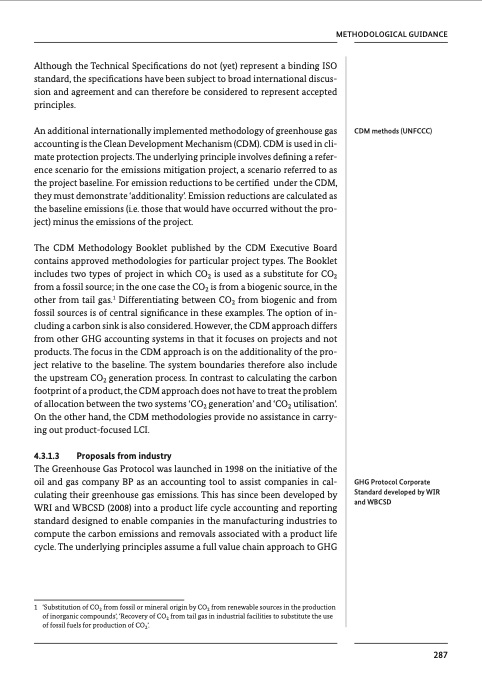
PDF Publication Title:
Text from PDF Page: 290
METHODOLOGICAL GUIDANCE Although the Technical Specifications do not (yet) represent a binding ISO standard, the specifications have been subject to broad international discus- sion and agreement and can therefore be considered to represent accepted principles. An additional internationally implemented methodology of greenhouse gas accounting is the Clean Development Mechanism (CDM). CDM is used in cli- mate protection projects. The underlying principle involves defining a refer- ence scenario for the emissions mitigation project, a scenario referred to as the project baseline. For emission reductions to be certified under the CDM, they must demonstrate ‘additionality’. Emission reductions are calculated as the baseline emissions (i.e. those that would have occurred without the pro- ject) minus the emissions of the project. The CDM Methodology Booklet published by the CDM Executive Board contains approved methodologies for particular project types. The Booklet includes two types of project in which CO2 is used as a substitute for CO2 from a fossil source; in the one case the CO2 is from a biogenic source, in the other from tail gas.1 Differentiating between CO2 from biogenic and from fossil sources is of central significance in these examples. The option of in- cluding a carbon sink is also considered. However, the CDM approach differs from other GHG accounting systems in that it focuses on projects and not products. The focus in the CDM approach is on the additionality of the pro- ject relative to the baseline. The system boundaries therefore also include the upstream CO2 generation process. In contrast to calculating the carbon footprint of a product, the CDM approach does not have to treat the problem of allocation between the two systems ‘CO2 generation’ and ‘CO2 utilisation’. On the other hand, the CDM methodologies provide no assistance in carry- ing out product-focused LCI. 4.3.1.3 Proposals from industry The Greenhouse Gas Protocol was launched in 1998 on the initiative of the oil and gas company BP as an accounting tool to assist companies in cal- culating their greenhouse gas emissions. This has since been developed by WRI and WBCSD (2008) into a product life cycle accounting and reporting standard designed to enable companies in the manufacturing industries to compute the carbon emissions and removals associated with a product life cycle. The underlying principles assume a full value chain approach to GHG 1 ‘Substitution of CO2 from fossil or mineral origin by CO2 from renewable sources in the production of inorganic compounds’, ‘Recovery of CO2 from tail gas in industrial facilities to substitute the use of fossil fuels for production of CO2’. CDM methods (UNFCCC) GHG Protocol Corporate Standard developed by WIR and WBCSD 287PDF Image | Chemical Processes and Use of CO2

PDF Search Title:
Chemical Processes and Use of CO2Original File Name Searched:
CO2_Buch_engl.pdfDIY PDF Search: Google It | Yahoo | Bing
NFT (Non Fungible Token): Buy our tech, design, development or system NFT and become part of our tech NFT network... More Info
IT XR Project Redstone NFT Available for Sale: NFT for high tech turbine design with one part 3D printed counter-rotating energy turbine. Be part of the future with this NFT. Can be bought and sold but only one design NFT exists. Royalties go to the developer (Infinity) to keep enhancing design and applications... More Info
Infinity Turbine IT XR Project Redstone Design: NFT for sale... NFT for high tech turbine design with one part 3D printed counter-rotating energy turbine. Includes all rights to this turbine design, including license for Fluid Handling Block I and II for the turbine assembly and housing. The NFT includes the blueprints (cad/cam), revenue streams, and all future development of the IT XR Project Redstone... More Info
Infinity Turbine ROT Radial Outflow Turbine 24 Design and Worldwide Rights: NFT for sale... NFT for the ROT 24 energy turbine. Be part of the future with this NFT. This design can be bought and sold but only one design NFT exists. You may manufacture the unit, or get the revenues from its sale from Infinity Turbine. Royalties go to the developer (Infinity) to keep enhancing design and applications... More Info
Infinity Supercritical CO2 10 Liter Extractor Design and Worldwide Rights: The Infinity Supercritical 10L CO2 extractor is for botanical oil extraction, which is rich in terpenes and can produce shelf ready full spectrum oil. With over 5 years of development, this industry leader mature extractor machine has been sold since 2015 and is part of many profitable businesses. The process can also be used for electrowinning, e-waste recycling, and lithium battery recycling, gold mining electronic wastes, precious metals. CO2 can also be used in a reverse fuel cell with nafion to make a gas-to-liquids fuel, such as methanol, ethanol and butanol or ethylene. Supercritical CO2 has also been used for treating nafion to make it more effective catalyst. This NFT is for the purchase of worldwide rights which includes the design. More Info
NFT (Non Fungible Token): Buy our tech, design, development or system NFT and become part of our tech NFT network... More Info
Infinity Turbine Products: Special for this month, any plans are $10,000 for complete Cad/Cam blueprints. License is for one build. Try before you buy a production license. May pay by Bitcoin or other Crypto. Products Page... More Info
| CONTACT TEL: 608-238-6001 Email: greg@infinityturbine.com | RSS | AMP |